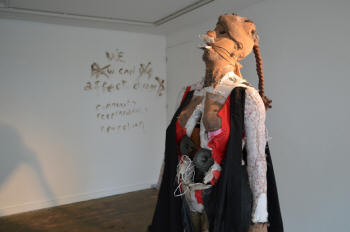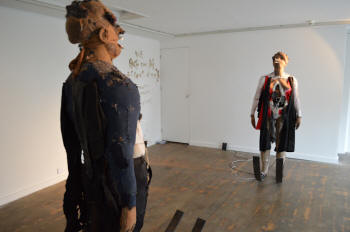|
|
| home | exhibitions | interviews | features | profiles | webprojects | archive |
|
Something is not quite right Richard Davey
Driving along a street or country road, we might sometimes come across a pile of discarded clothes lying strewn across the verge. They feel out of place; their torn, stained presence a blot on the landscape. Looking at them our minds invent stories and imagine scenarios; we think about those who have left them there. Do they hint at something sinister, or are they the unwanted detritus of those who simply don’t care?  We
might hope for a world without hate, horror or evil, but the reality
is unfortunately different. Wherever we look we are confronted by
images that can shock or terrify. The brutal truth comes into our
living rooms on a daily basis, showing us men kneeling, waiting in
terror for the blade to start cutting, or suicide bombers blowing
themselves up. Although we know we can look away, many of us don’t.
We are drawn to the flame of fear, not wanting to watch yet unable
to stop. Ultimately, however, these are only pixelated
representations without three dimensional substance. They shock with
their unrelenting detail, but they can’t inhabit our space or invade
our safety zone. We
might hope for a world without hate, horror or evil, but the reality
is unfortunately different. Wherever we look we are confronted by
images that can shock or terrify. The brutal truth comes into our
living rooms on a daily basis, showing us men kneeling, waiting in
terror for the blade to start cutting, or suicide bombers blowing
themselves up. Although we know we can look away, many of us don’t.
We are drawn to the flame of fear, not wanting to watch yet unable
to stop. Ultimately, however, these are only pixelated
representations without three dimensional substance. They shock with
their unrelenting detail, but they can’t inhabit our space or invade
our safety zone.Tim Shaw, on the other hand, is an artist who physically confronts us with vivid representations of these things. They may not have the realism of a photograph, but they inhabit our space and in doing so they cause our bodies to tingle and recoil at their physical proximity and unsettling appearance, filling us with that involuntary frisson of neurological energy that is produced in moments of terror and uncertainty. As a seven year old boy, Shaw had experienced such a moment of terror. Sitting at a café with his mother, he remembers being caught up in one of the twenty bomb blasts that rocked Belfast for eighty minutes on Bloody Friday, 1972. Decades later, Shaw referenced these boyhood memories in his immersive installation Mother, The Air Is Blue, The Air Is Dangerous. The wail of sirens rings out from loudspeakers. The floor is covered in overturned tables, chairs, old clothes and shoes. On the walls we can see the shadowy forms of slowly running people, whilst dinner trays spin through air filled with a blue haze. But like memories that become distilled and crystallised over time, this is no longer a specific representation of the centre of Belfast on a July afternoon but something more universal: it is an invitation to journey into the heart of terror, when the world slows down, everything becomes more intense, and we stand momentarily rooted to the spot. An emphasis on exaggeration, elimination and distortion is a defining characteristic of Shaw’s figures, whose grinning mask-like faces, with bulging eyes and proboscis noses, reflect his interest in medieval art, the paintings of Pieter Brueghel, Francisco Goya, and Otto Dix and the dramatic, emotionally intense sculptures of Auguste Rodin. They appear unreal, and yet they have a familiarity that stops them being mere caricatures, for as much as they push the boundaries of the human form they still conform to basic principles of classical modelling and proportion. And this is what makes them so disturbing: they are human enough to evoke empathy, but inhuman enough to disquiet and terrify. Shaw’s use of old clothes, shoes and bedding, with its obvious reference to roadside detritus, contributes to this underlying sense of unease. When seen from a car window abandoned bundles of fabric are merely anonymous flashes of colour. When reanimated into breath-less life by Shaw, they are once again items of clothing. As his figures loom over us in a sinister claustrophobia of complicity, they force us to stare at pillows and items of clothing that feel stained with the presence of their previous owners. Their stocking flesh turns us into involuntary voyeurs, staring at fabric that was once in such intimate contact with another person’s body. Although their subject matter may be universal, their fabrication brings them back to the particular and personal.
There is a sense of ambiguity to this figure
though, which is also present in Soul Snatcher Possession.
Here is an ominous situation bristling with a sense of imminent
threat that most would avoid. A hooded figure stands hemmed in
and encircled by three figures, whose intimidating proximity and
aggressive body language suggests something sinister about to
take place. Observing the dynamics of power and powerlessness,
weakness and strength within the group we instinctively make
judgements that decide who is the victim and who are the
perpetrators. But this assumption is all in our mind. There is
nothing in either Alternative Authority or Soul
Snatcher Possession to say that the ‘victim’ may not once
have been the perpetrator’, and the ‘perpetrators’ the victims.
This ambiguity is also seen in the work’s side
drama, where we see a woman leaning against a wall, her hand
resting near her knickers, her head looking away, pinned to the
wall by a streak of stocking that distorts her face so that it
is impossible to tell whether her expression is one of horror or
ecstatic pleasure. A man looks on, a sinister voyeur. Is he
paying her, compelling her, or controlling her by some hidden
threat? On the floor is a syringe. Has he drugged her or is she
an addict? Again, Shaw remains neutral, leaving it to the
viewer’s imagination to decide.
Complicity is central to Shaw’s works. It forms
the subject of Defending integrity from the powers that be,
where the two precariously balanced figures, rocking on their
vicious metal blades, their mouths filled with the wads of cash
that silence them represent, for Shaw, those victims of
injustice who are unable to speak out because of their acts of
unwitting collusion and collaboration. It also underpins the way
Shaw engages the viewer. He doesn’t want the viewer to be an
onlooker observing the act, but a participant asked to make
judgements.
 The
response of the viewer is central to Shaw’s work. He wants us be
aware of our hesitation at their eerie, unsettling forms; he
wants us to be repulsed at their jumble sale manufacture and
broken, shattered elements. By doing so he forces us to realise
that evil, and the perception of evil, is not just something to
be found outside of ourselves, but can be in our naming of the
act as well. We find ourselves making assumptions when we look
at his figures. We impose an aura of malevolence and disquiet
without concrete evidence, reacting in fear and loathing before
we are told to do so. We see the voyeur and the drug addict and
not the person and their story; the abandoned clothes and not
the person who owned them. This is what Shaw explores in his
art. He doesn’t just show us the darkest corners of human
behaviour, but our own, often prejudiced responses. He does so
by neither condemning nor sympathising, but always leaving us to
draw our own conclusions just as we have to in real life. The
response of the viewer is central to Shaw’s work. He wants us be
aware of our hesitation at their eerie, unsettling forms; he
wants us to be repulsed at their jumble sale manufacture and
broken, shattered elements. By doing so he forces us to realise
that evil, and the perception of evil, is not just something to
be found outside of ourselves, but can be in our naming of the
act as well. We find ourselves making assumptions when we look
at his figures. We impose an aura of malevolence and disquiet
without concrete evidence, reacting in fear and loathing before
we are told to do so. We see the voyeur and the drug addict and
not the person and their story; the abandoned clothes and not
the person who owned them. This is what Shaw explores in his
art. He doesn’t just show us the darkest corners of human
behaviour, but our own, often prejudiced responses. He does so
by neither condemning nor sympathising, but always leaving us to
draw our own conclusions just as we have to in real life.
These underlying themes of complicity and moral
ambiguity are not just carried by the subject matter or viewer’s
response, however, they are in the work’s construction as well.
Whilst their appearance is often repulsive and unattractive, in
order to make them Shaw has had to hold them and manipulate
them. He has had to choose and work with materials that have
been thrown away. He has had to massage and caress distorted
forms until they appear ‘right’. The existence of these
untouchable forms is therefore the product of touch, these
undesirable things have come about through deliberate choice and
selection. They are disturbing and threatening because they are
falling apart, their stuffing oozing out of their seams and
joins, their metal feet jagged and sharp, shoes ripped and
broken, eyes bulging. They are made from the products of decay
and death, yet from this dissolution comes something new.
Shaw gives us hope without ever showing us hope.
He takes abandoned clothes and remakes them. He shows us that
what appears objective is in reality subjective. He turns the
viewer into the subject and makes his sculptures the observer.
He highlights the ambiguous nature of the world, making us
realise that a victim might be the perpetrator and the
perpetrator might be the victim. At one point in the monologue
given by his animatronic sculpture, Breakdown Clown, the
grotesque figure faces the viewer and says: ‘We are no
different. All just wires, soft flesh hung onto hard
form. Impulses running down those stringy bits. And when the
life force leaves the form, and the water evaporates, we are
dust. You and me………’.
In fairytales the world is polarised between dark
and light, good and evil. Shaw, however, refuses to be that
simplistic. Instead, he exposes the rich palette of grey that
exists in the real world. He reminds us, that for every act of
evil, horror, and terror we have witnessed, there is an also an
act that exists because we have named it or participated in it,
through our own preconceptions, judgements, biased attitudes, or
silent complicity. Here is the key to Shaw’s work; the
underlying conviction that makes it so compelling and real: the
realisation that underneath our apparent differences we are all
the same.
Dr Richard Davey is an internationally published author, curator and member of the International ‘Association of Art Critics’. He is a judge of the John Moores Painting Prize 2016 and recently wrote the major exhibition publication for Anselm Kiefer’s solo exhbition at the Royal Academy of Arts, in 2014 alongside the 2015 and 20 16 ‘RA Summer Exhibition’ catalogues. |
|
|
